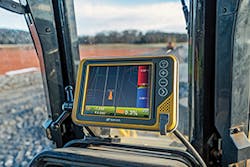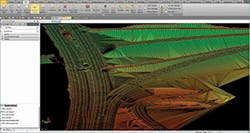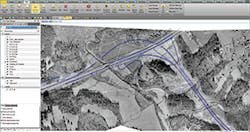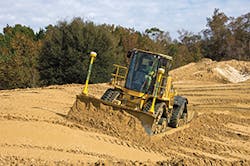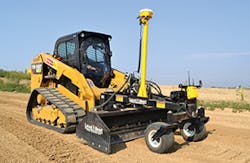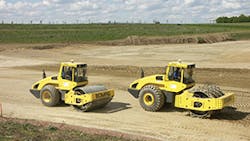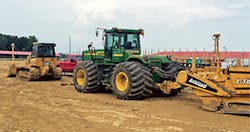From GX June 2016
Mike Bowman, president of M & C Excavating in Fountaintown, IN, has used machine control technology in his business for some time.
“If you’re going to be competitive, you will have to get into this,” he says. “I don’t think you’re going to have a choice. It’s a big player on efficiency, and how we make money is with our efficiency.”
Acknowledging the upfront investment can be daunting for a contractor, points out Bowman. His company is a small commercial excavation firm with 10 employees who do earthmoving work for storm, sanitary sewer, and water lines using Caterpillar equipment.
Yet, three of the company’s four dozers are running on machine control. Bowman recently purchased the company’s first machine control-equipped excavator. The company also has GPS and machine control on one of its tractors and pull pan.
Bowman’s decision to use machine control wasn’t much of a leap in faith, having spent 13 years as an automation electrician at a large factory. “I was very comfortable with automation from a knowledge standpoint, so when I got into excavation, I read an article about how the technology was evolving,” he says. “I stayed on top of what technology was coming out. As I was upgrading my equipment, I made sure the upgrades included the control valves on the dozers to accommodate machine control.”
At first, Bowman purchased a used system. “I didn’t have the massive out-of-pocket expense that I think scares people,” he says. “They’re scared they have to spend $80,000 to set up one machine. You do it a little at a time and prepare for it as you’re upgrading equipment. My first expenditure was only $26,000 to get started with my first system.”
Soon, Bowman saw the quick payback and efficiencies it offered. He has continued to incorporate additional technology to his company’s fleet, noting “it’s been a really big success for my company.
“What used to take a week to do sometimes we can accomplish in one day,” says Bowman. “If we’re trimming a parking lot and we can get stone to come in the same day, we can trim and put stone down.
“Before, we were constantly pulling strings, checking grade, and going over it. You have to have a surveyor stake it as you’re getting ready. If the weather catches you before you get done, you have to wait on the weather. Now once we calibrate a site and know where we’re at grade-wise with the model we have, we can cut it and stone it back to back, even the same day.”
Showing a Data Pro vertical surface
Machine control also offers him a competitive edge, points out Bowman. “When a new customer finds out I’m running GPS, it’s interesting to them,” he says. “Their thinking is ‘if he has put all of this time and money into this technology, he obviously knows what he’s doing.'”
There is an array of technology and software from which to choose.
Topcon Positioning Systems has introduced the 3D-MCMAX bulldozer system for GNSS machine control. “This Inertial Measurement Unit sensor system uses state-of-the art sensors that have gyroscopes and accelerometers to measure movement of the cutting blade,” says Dave Thomas, manager of construction channel marketing for Topcon Positioning Systems. “This eliminates the need for a 6-foot mast with GPS antenna on the cutting blade to establish position.”
A Data Pro horizontal view
The new system is designed to improve safety by eliminating the mast on the blade and significantly increase grading performance at high operating speeds and when operating on tight turns and steep slopes, he adds.
Data Pro creates three-dimensional (3D) data for automated machine guidance (AMG) equipment for construction, getting it from design to the field for all of the various pieces of equipment found on a construction site.
The company also provides consultation services for contractors to help them in the technology’s implementation so as to leverage its productivity, says Bruce Flora, Data Pro president, who also serves as a certified Trimble trainer for heavy construction software.
Flora points out the majority of today’s designs are geared toward two-dimensional (2D) paper prints. “Even though a lot of design is produced in three dimensions, the deliverables of the product we get in the field is pretty much two dimensional with maybe some CAD data behind it,” he says.
John Deere high-speed dozer equipped with Trimble GradeMax Plus
Data Pro’s technology transforms a 2D plan which may include CAD data into a 3D model that includes drainage flows, inlet elevations, percentages, and road geometry, among other factors. “We massage it to be compatible with machine control,” says Flora, adding that the machines will only be as accurate as the data that controls it and that designs normally aren’t made to the accuracy that is provided by AMG, fueled by such software.
In addition to accuracy, there are benefits such as safety and liability to be gained through AMG, notes Flora, adding that the waste industry—especially in the private sector—embraces such technologies for cost avoidance.
Trimble machine control technology on a Cat 279D
Case in point: real-time certification for landfill cell construction. “We have developed techniques using the technology via the 3D and GPS that we can [use to] certify if a landfill is built properly real-time in the field to increase the productivity of the field work—and if it’s not certified, we can tell them in real time what to fix,” he says. “If it is certified, we store it and it goes right into the as-builts.”
Flora points out that properly utilized machine control eliminates rework, and increases productivity and efficiency through reduced costs in fuel, labor, and overall job costs. “It’s a green technology,” he adds.
Increased safety is another benefit. “It takes people off of the ground,” says Flora. “The operator is using a computer to help him do his job and you don’t have people on the ground putting in stakes and pulling string line. You can put pipes in and grade them without people measuring down in the trench.”
Proper training is critical for companies to derive the full range of machine control benefits, points out Flora.
Flora cites two aspects that ensure the success of its proper use. “First is creating the 3D data accurate for what you’re trying to achieve in the field,” he says. “The machine will build it wrong very accurately. ‘Garbage in, garbage out’ is the old phrase we used to use in the computer world.”
The second aspect is horizontal and vertical control. “The problem we have nowadays is there is an original surveyor or somebody who comes out and does an exiting conditions plan, making a map of what is there,” says Flora. “That goes to the design engineer. That same horizontal and vertical control should now move to the field for the contractor to build with. The original surveyor, who is setting up the original control for design, is going to be concerned about geospatial.
“When it comes through design ready for construction, the construction surveyor is more concerned with project control—the control that was set on the ground is what he’s tying into. How it was geospatially arrived at is none of his concern. We get a lot of people now trying to come in and use geospatial during construction and we’re getting conflicts.”
The ongoing adjustment of geospatial data contributes to that challenge. “They’ve probably adjusted it five times in the last 10 years,” says Flora, adding that if a job had been designed a few years ago and a contractor tried to utilize geospacing today, there is a chance the location would be different. “We’ve had a lot of conflicts there. Nobody is building anything wrong. They’re just different than what the design said.”
Trimble recently released additions to its machine control portfolio to target a wider group of contractors, notes Jeff Drake, business area manager for Trimble machine control systems.
For earthmoving contractors, the Trimble GCS900 grade control system for dozers, motor graders, and excavators has design surfaces, grades, and alignments inside the cab. The GCS900 version 12.7 features GradeMax Plus, a new technology designed to increase the overall performance of dozers by allowing the operator to grade faster and more consistently with tighter accuracy.
The system uses the Trimble GS420 Inertial Measurement Unit sensor to detect the current rate of acceleration and changes in orientation. Trimble also has increased the rate at which the GCS900 system drives the valves on the dozer for smoother, more consistent control and rapid recovery of the dozer blade, “so operators can grade higher quality surfaces at even faster speeds,” says Drake.
GradeMax Plus enables operators to grade a wider range of complex surfaces without constraints. “For example, operators have the freedom to rotate the dozer blade during operation on steep slopes while maintaining constant grading speeds,” says Drake.
The Trimble CCS900 Compaction Control System for soil compactors with wireless data share provides machine-to-machine communication that gives operators the ability to share mapping data between compactors on the same site in real time so they know which areas have been compacted and which still need to be completed, says Drake.
“Additionally, new layer management functionality allows operators to view the layers or lifts other compactors are working on,” he says. “The real-time display of this information in the cab enables the operator to achieve more consistent compaction while also reducing the amount of under- and over-compacted areas. This not only improves surface quality, but can also save time and fuel.”
The mapping information is synchronized back to the office for progress monitoring, compaction documentation, and reporting, using Trimble’s VisionLink asset management and project monitoring software.
Trimble recently expanded its paving portfolio to include a slipform concrete paving machine control solution, the Trimble PCS900 Paving Control System for Guntert & Zimmerman and GOMACO placer/spreader machines.
The system is designed to further automate the slipform paving train by allowing contractors to use GNSS-based positioning in conjunction with a base station to steer the machine and control its elevation according to the 3D model, says Drake. “This can significantly improve paving productivity and reduce material waste on concrete roads and airport surfaces,” he adds.
Bomag CCS 900 compactors with Trimble CCS900 Compaction Control System for soil compactors
For small contracting operations, Trimble recently added a dual GNSS solution for compact machines such as skid-steer loaders. The Trimble GCS900 3D Grade Control System for Bobcat HD grader attachments is designed to enable small contracting operations to work faster and more effectively on complex projects requiring digital designs and 3D machine control.
“Large contracting operations also can benefit by using 3D machine control to complete the finish phase of projects more affordably and accurately with their Bobcat machines,” says Drake. “Using digital 3D models prepared in Trimble’s Business Center–HCE office software, the Trimble GCS900 system is ideal for footpaths, parking lots, and sidewalks.”
As part of Trimble’s Connected Site solutions, the system includes the ability to wirelessly sync files to the machine, track assets and site productivity, and receive remote support or training, says Drake.
The Trimble GCS900 3D system is available as an upgrade from the 2D laser-guided and sonic/slope systems already offered by Bobcat. The Trimble GCS900 3D Grade Control
System for ATI Level Best Grading Boxes is designed to allow small contracting operations to work more quickly and efficiently on complex projects requiring 3D machine control and digital designs, says Drake.
“3D machine control on skid-steer loaders can also benefit large contracting companies by allowing them to complete the finish phase of projects with added precision and at a lower cost,” says Drake. “The Trimble GCS900 system is perfect for footpaths, parking lots, sidewalks, and other surfaces that require a 3D-constructable model, which can be built in Trimble’s Business Center–HCE office software.”
Additionally, the system is part of the Trimble Connected Site solutions portfolio so contractors can wirelessly sync files to the machine, track assets and site productivity, and receive remote support or training, he adds.
Drake says Trimble has made connectivity standard and included with its machine control products. A six-month subscription for high data rate communications and access to the company’s cloud-based collaboration platform with its VisionLink telematics is included with the purchase of a machine control system.
Drake points out that SITECH distribution and end users are increasingly using remote connectivity on and off the job site to streamline processes such as sending and receiving 3D digital designs, production data, and remote support tools. “It also allows contactors to use the system off of Trimble VRS Now networks and other local Internet base station services, reducing the need for fixed GNSS infrastructure on their job sites,” he adds.
Caterpillar’s latest offering in GPS laser machine control is Grade with Assist on the company’s 323F excavator, a hardware and software addition which adds semi-automatic control to its current Grade 2D offering.
“This will control the boom and the bucket as the operator controls the stick function and it maintains the bucket teeth on grade,” notes Scott Hagemann, Machine Control & Guidance Application Specialist for Caterpillar, adding that it will also work with GPS if the customer wants to work a 3D design.
Carlson Software will soon release a new Office Software platform, with the application moving to a flexible Web-based platform, notes Tim Jones, director of machine control.
To what extent machine control has penetrated the market depends on geography. “The construction industry as a whole is dramatically under-penetrated,” says Drake of the role of machine control. Globally, market indicators suggest machine control penetration rates are less than 20%, he adds.
“Trimble is addressing this by establishing a global SITECH distribution network,” says Drake. “SITECH dealers are construction technology professionals with the expertise to help contractors purchase and get training and support using Trimble machine control technology and other solutions focused on providing value at all points in the contractor’s construction continuum.”
On the other hand, Bowman says the use of machine control is common in the Indiana region in which his company does business with Caterpillar machines.
Hagemann echoes that, noting a positive penetration of machine control in markets where contractors possess models for which CAT offers technology from the factory, adding that technology is a “standard conversation” with most contractors now.
“Contractors have been very pleased with the integrated systems,” he says. “After operating, they are always asking for more models. Some of our dealers are standardizing on the factory technology solutions when they order machines due to contractors’ demands. For the contractors’ current machines, we have SITECH dealers who can supply an aftermarket solution.”
There are many driving factors for the adoption of machine control.
Project developers are increasingly requiring technology on machines, helping to drive adoption of the technologies, says Hagemann.
Competition is the driving factor for AMG adoption, says Flora. “There are certain areas where contractors are putting their arms around this and grasping it because all of a sudden people are finding themselves in a position where it’s hard to compete,” he says. “Machine control is allowing them to do more with less. It’s also allowing for some efficiencies for the contractors who want to move forward.”
“As the next generation of machine operators continues to become less specialized and there are fewer 20-year operators, modern contractors are seeing the necessity of utilizing machine control systems,” points out Thomas. “However these contractors and owners who have adopted machine control are finding that even their seasoned operators can double their productivity by using blade automation.”
Ashland towed scraper with machine control system
Flora agrees that AMG is providing a solution for the challenge grading and excavation contracting companies have finding skilled employees willing to work in the construction industry, says Flora.
AMG could be a selling factor for young adults who gravitate toward using technology in their jobs, he adds.
“We’ve seen where some of the younger kids don’t want to go to a full four-year college and become a political science major,” says Flora. “They like doing something with their hands, and using their head, and with technology in construction now, that is there for them.
“We’re getting a lot of older guys fighting the technology, and getting a lot of the younger people coming in just pushing buttons and don’t really have the experience or wisdom you can only get by working in the industry for so many years,” says Flora, adding that having both types of employees on hand and leveraging their strengths creates an optimal workforce.
Flora says he believes the day is coming when every contractor will have machine control in the construction equipment. One of his areas of specialty is landfills for waste operations such as Waste Management and Republic Services.
“They demand machine control on their sites,” notes Flora. “They won’t even let the traditional, conventional contractor bid anymore because they want the efficiencies of machine control and the technology it can bring.
Flora also specializes in the heavy highway sector, making data and training for heavy highway equipment. “I’m running into the same thing there where I’m working with contractors who are really concerned about efficiencies in the future and are embracing this all the way, whereas the public agencies are not,” he says.
In terms of the driving factors leading contractors to employ the latest technologies, Drake notes that “since the inception of GNSS-based machine control 20 years ago, we’ve seen a dramatic transition from early adopter contractors who purchased technology because they thought it would give them an edge over their competitors to an increasing number of contractors in the early majority that require GNSS-based machine control because it is more standardized in their local markets.”
It’s the “new normal,” notes Drake. “They need it to continue to win projects or bid on projects that now have machine control technology called out in the bid specifications. In this case, machine control growth has increased due to an increasing awareness of project owners and government agencies requiring the use of machine control technologies because the efficiency, productivity increases, and reduction—and in some cases elimination of—project waste in lean construction is now accepted.”
Yet, there still seems to be barriers to widespread adoption of machine control. The age of the machines is one such barrier, says Hagemann.
“The newer models of Cat machines have the more technology-advanced functions,” he says. “The machines with EH controls, displays that have more processing power, and sensors that are standard on the machine have helped contractors overcome barriers. We have leveraged these components and we have also helped drive the requirements for the new machines.”
Financial concerns are another barrier. “A lot has to do with the economy and risks and uncertainties of running a business,” says Flora. “Nobody wants to dive in financially with the uncertainties that we in business today have.”
Jones concurs that the biggest barrier to contractors using machine control technology is the justification of the capital to ensure they are getting payback from their investment.
Drake agrees. “An initial purchase of 3D GNSS-based machine control systems, supporting job site infrastructure, and office software can be seen to be expensive in the eyes of a contractor new to the technology,” he points out.
Acknowledging that cost concerns are a significant barrier to contractors using machine control, Thomas notes that “it gets obliterated by contractors new to this type of tech when they are able to double production and recoup the system costs after one six-month job or even less.
“They then own the system and, with a Topcon system, are able to move that control box to other machines or even move between dozer and graders,” he adds. “Also, if they’re renting their machines, they can also take it with them and install on future rentals.”
Another barrier is resistance to changing the way work is done. “Machine control requires changes to be made to the process in which construction is performed when machine control is used,” says Drake.
Public policy may be underscoring that resistance to change, notes Flora. “Somebody has to some way, somehow get up to a higher level for the policymakers to open their eyes that this technology is here to stay and the benefits are there,” he says. “They’re going to have to get the policymakers to put it in the policy that 3D is what’s going to be delivered for construction from now on.
“The way the engineering community and public sector works is once they are done with their design, they’re onto the next job. What we’re trying to tell them is it’s not really done until we design it, construct it, and start using it, and the data should go all the way through the life cycle.”
That life cycle starts with 3D, which is the design and machine control; moves through to 4D, which is scheduling; and then to 5D, which is taking scheduling, costs, and maintenance and moving it through the life cycle, says Flora.
The resistance could be changing in favor of automation.
Flora conducts workshops for the US Federal Highway Administration (FHWA), which he indicates is trying to advocate automation through its EDC3 (Every Day Counts) initiative.
FHWA calls it e-Construction, a paperless construction administration delivery process that includes electronic submission of all construction documentation by all stakeholders, electronic document routing/approvals (e-signatures), and digital management of all construction documentation in a secure environment allowing distribution to all project stakeholders through mobile devices.
A paper-based system that requires significant time and money to create through conventional postal delivery, project journals, note-taking, stamped plan sets, design and construction submittals, and physical signatures on multiple copies of many documents is becoming obsolete, notes the FHWA.
Its initiative “aims to employ established technologies that are readily available to the transportation community, such as digital electronic signatures, electronic communication, secure file sharing, version control, mobile devices, and Web-hosted data archival and retrieval systems to improve construction documentation management,” according to the FHWA website.
Drake cites two additional factors that have served as the biggest barriers for contractors to get the technologies into their machines.
One is the awareness of the benefits and capabilities of the technology, he says, adding that many contactors have not been informed of or visited by professionals who are experts in the technology.
Another is not having personnel on staff who can assist with the technology deployment and management. “There is a perception by new users that technology experts are required to be on the contractor’s staff in order to use the technology,” says Drake, adding that Trimble’s SITECH network of global construction technology consultants and distributors was established to address that.
Thomas points out that one of the largest barriers to adopting machine control is “an aversion to new technologies by more traditional operators. However, with even the most stern technology holdouts, we’re noticing a huge momentum shift over just the past few years. With wide-scale adoption of the iPhone and other common technologies like tablets, smart watches, and even thermostats, everybody is starting to trust technology more.”